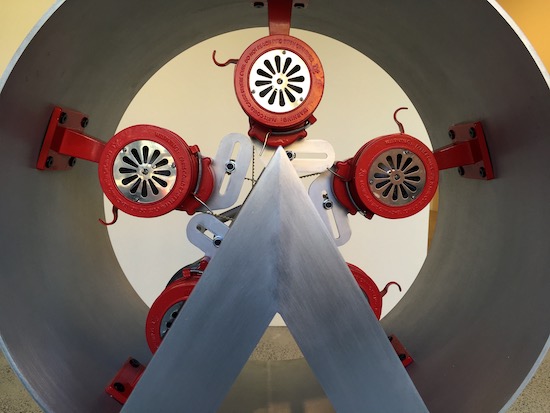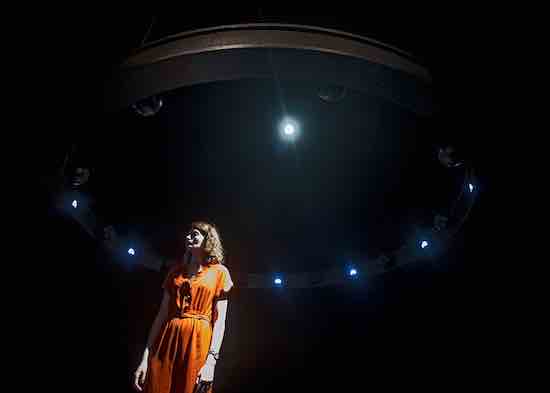Aura Satz, Tuning Interference: Dark Matter Radio (2019) at Science Gallery London. Ten speaker sound installation. Photo by George Torode
To experience Aura Satz’s Tuning Interference: Dark Matter Radio is to step into a ring of sound. The work, currently on display as part of the Science Gallery’s Dark Matter exhibition consists of a circular array of ten small loudspeakers each issuing ripple-like sonifications of data simulating dark matter, the mysterious shadow-self of the universe, thought to account for some 85% of all matter. Between the speakers, small dials like the VU meters on old mixing desks tremble and quaver, seemingly taking measurements of – what, exactly?
Seeing Tuning Interference at the exhibition’s opening night, I watched as other gallery visitors tried to experiment with the installation, moving back and forth and waving their arms before it, convinced that the device was responding to their movements in some way, that sensors were tracking them and modulating the emitted sounds in return. They were not.
But the attendees’ confusion was understandable. The sound did seem to change. Moving about the space, turning your head from side to side, strange fluctuations emerged: beat frequencies and different tones. Tuning Interference’s liquid tones produce a cocoon of psychoacoustic effects, a network of invisible energies, which the visitor is invited to feel one’s way around, effectively tuning in and out of its diverse lines of force. The body becomes a radio.
“It plays on this idea of interference patterns as a starting point,” Satz tells me when we meet up in her East London studio space, “of tuning as a kind of embodied experience, the constant feedback loop, as with the hand on the dial, between what you’re hearing and what you do with your body.” She was inspired, she tells me, by a quote from Gray Rybka, a spokesman for ADMX, the US Department of Energy’s axion haloscope project, at the very forefront of dark matter research. “If you think of an AM radio, it’s exactly like that,” Rybka says. “We’ve built a radio that looks for a radio station, but we don’t know its frequency. We turn the knob slowly while listening. Ideally we will hear a tone when the frequency is right.”
Sound as a nexus of interconnections between the body and its technological prostheses has been an overriding concern of Satz’s for over a decade now. From short films dedicated to Daphne Oram to collaborations with Laurie Spiegel, Pauline Oliveros, and Beatriz Ferreyra, female pioneers of electronic music have provided a point of access to a possible feminist sound practice. “The sound comes from the writing,” Satz says, of Oram and Spiegel in particular. “So the sound isn’t a pre-existing sound that you then adjust. You instantiate a new alphabet of sound, a new form of notation and a new understanding of code – of where the sound takes place, who performs it. It’s this synthesized sound that comes from nothing. It doesn’t have a body.”

Aura Satz, The Wail That Was Warning, 2018, at Fridman Gallery, New York. Five daisy chained sirens mounted on aluminum. Photo by Adam Reich
“When Daphne was working with electronic music in the 60s and 70s, it was immediately absorbed into sci-fi or horror films,” Satz says. In many such films, electronic sound is not merely the accompaniment but a kind of avatar or stand-in for alien or variously othered bodies that cannot be represented in themselves, that quite literally can’t be seen (either because too horrifying – or because the special fx budget was simply too small). There is a pervasive and uncanny question Satz formulates as, “what body is this that makes this sound?” That, Satz says, “is really interesting to me in relation to gender.” Much as the term ‘computer’ once referred to women, sat at desks in rows, literally carrying out computations, before the word was transferred to the new technology of digital machines; the often female-coded ‘voice’ of the theremin and other electronic sound sources became a figure of the numinous and unknown, of the technological sublime.
Over the past decade, Satz’s practice has expanded to encompass the beginnings of a wholescale reconstruction and re-imagining of the contemporary soundscape – from the most prosaic (the beeping dial tone that structures a conversation between Spiegel and Oliveros in the work Dial Tone Drone) to the most exceptional and potentially catastrophic (the sirens that make up the sound sculpture The Wail That Was Warning and have been the focus of a more recent series of films focused on re-imagining warning signals for the twenty-first century). “Let’s shift what our sound alphabet might be, what kind of sounds might be emitted,” Satz says. “And in turn that will shift the way in which we listen.”
Sound, Satz suggests, can be thought of as a “cipher for ways in which we might understand our relationship to otherness. How do we allow other voices in? How are we able to listen to voices that aren’t in our echo chamber? Our listening is expanding, because there’s an increasingly noisy acoustic ecology. We’re listening differently – for many reasons – and we’re being listened to differently. Our attentions are being harnessed and instrumentalised within a wider economy of attention that’s being repurposed for capitalism. The way we fight back is to set the intention for how we listen, how we use our attention, where we put it.
“That’s a lot of what I’m interested in more generally,” she continues, “the space between signal and noise, between things that you can maybe intercept and those that were handed down to you. Let’s adjust the history a little bit and listen to other voices.”
Aura Satz’s Tuning Interference: Dark Matter Radio is on display at the Science Gallery, London, as part of the exhibition Dark Matter: 95% of the Universe is Missing, until 26 August 2019


